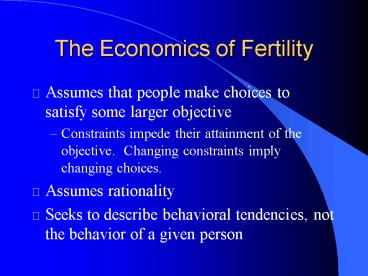The Economics of Fertility - PowerPoint PPT Presentation
1 / 7
Title:
The Economics of Fertility
Description:
Modifed Becker to include child quality. ... child supply (Cn) natural fertility (N) x survival rate (s) represents the number of children expected to survive ... – PowerPoint PPT presentation
Number of Views:46
Avg rating:3.0/5.0
Title: The Economics of Fertility
1
The Economics of Fertility
- Assumes that people make choices to satisfy some
larger objective - Constraints impede their attainment of the
objective. Changing constraints imply changing
choices. - Assumes rationality
- Seeks to describe behavioral tendencies, not the
behavior of a given person
2
Examples
- Gary Becker, et al.
- Satisfaction is derived from certain ultimate
goods that are produced with purchased resources
and ones own (or family) time. - Predicts that as the opportunity cost of parental
time rises, people will have fewer children. - Fails to predict that lower incomes will yield
more children
3
Models of Child Demand
- Becker and Lewis, 1970s
- Modifed Becker to include child quality. That
is, satisfaction of parents depends not only on
how many kids one has, but also the nature of the
kids, which is affected by expenditures on them - music lessons, good schools, computer camp
4
Child Demand
- Willis, 1970s
- Derived the conditions under which specialization
within the home would occur. - Utilized the notion of comparative advantage to
describe time use patterns of husbands and wifes.
5
Easterlin-Crimmins ModelBased on Fertility
Revolution
- child demand (Cd)
- number of children desired based on the net value
of children to parents assuming that avoiding
them is costless - depends on level of investment in children
desired by parents - old age security
- labor value of children
- opportunity cost of parental time
- parental consumption
6
Model Components
- child supply (Cn)
- natural fertility (N) x survival rate (s)
- represents the number of children expected to
survive to adulthood if no action is taken to
limit family size - cost of regulating fertility (RC)
- psychic and monetary cost of avoiding children
- may decline as society becomes more accepting of
contraceptives
7
Actual fertility does not follow Cd immediately
due to costs of avoiding children
Cn rises due to better health, declining
breast feeding
Cn, Cd C
Cn s N
C
Cd falls due to declining net value of children
Cd
Degree of Modernization































